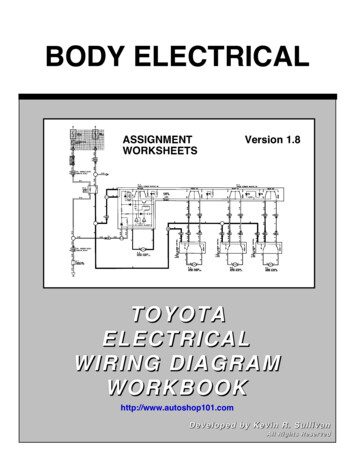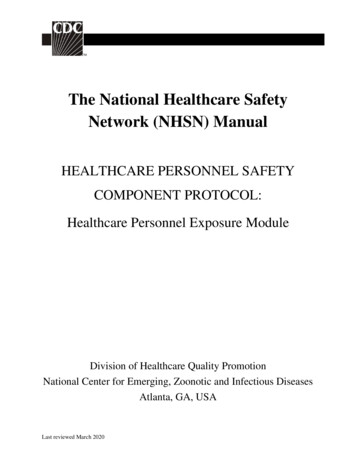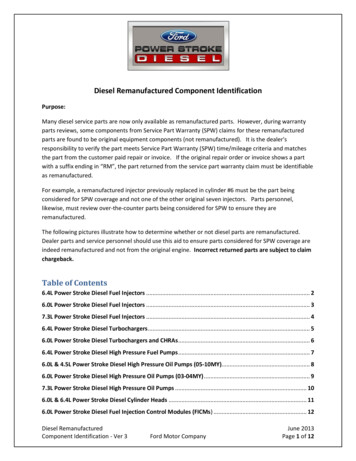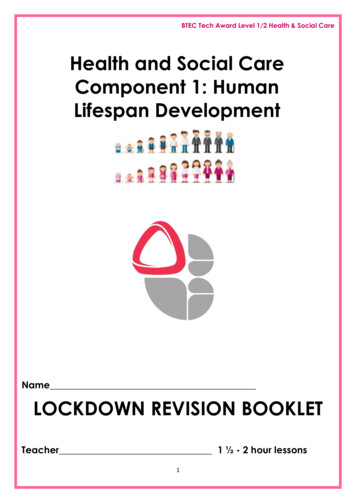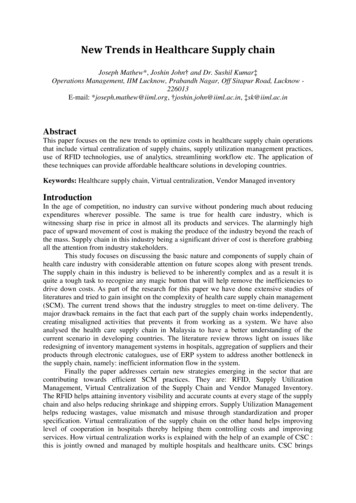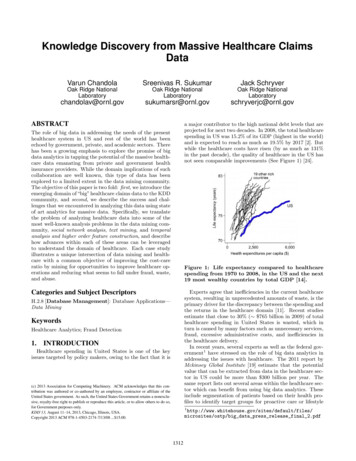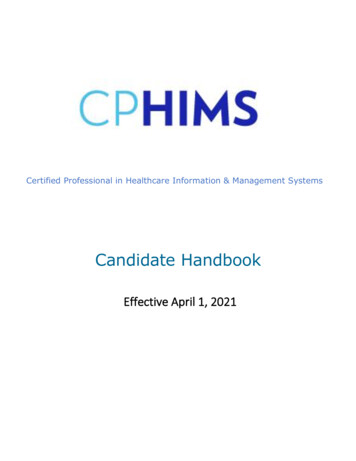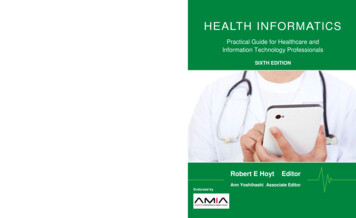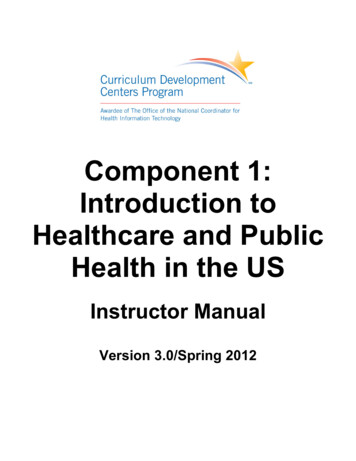
Transcription
Component 1:Introduction toHealthcare and PublicHealth in the USInstructor ManualVersion 3.0/Spring 2012
Notes to InstructorsThis Instructor Manual is a resource for instructors using this component. Eachcomponent is broken down into units, which include the following elements: Learning objectivesSuggested student readings, texts, reference links to supplement thenarrated PowerPoint slidesLectures (voiceover PowerPoint in Flash format); PowerPoint slides(Microsoft PowerPoint format), lecture transcripts (Microsoft Word format);and audio files (MP3 format) for each lectureSelf-assessment questions reflecting Unit Objectives with answer keysand/or expected outcomesApplication Activities (e.g., discussion questions, assignments, projects)with instructor guidelines, answer keys and/or expected outcomesHealth IT Workforce CurriculumVersion 3.0/Spring 2012Introduction to Healthcare andPublic Health in the USThis material was developed by Oregon Health & Science University, funded by the Department of Health and Human Services,Office of the National Coordinator for Health Information Technology under Award Number IU24OC000015.2
ContentsNotes to Instructors . 2Disclaimer . 7Component 1/Unit 1 . 8Component 1/Unit 2 . 12Component 1/Unit 3 . 18Component 1/Unit 4 . 21Component 1/Unit 5 . 30Component 1/Unit 6 . 36Component 1/Unit 7 . 43Component 1/Unit 8 . 45Component 1/Unit 9 . 47Component 1/Unit 10 . 50Component Acronym Glossary . 52Creative Commons Attribution-NonCommercial-ShareAlike 3.0 Unported. 54Health IT Workforce CurriculumVersion 3.0/Spring 2012Introduction to Healthcare andPublic Health in the USThis material was developed by Oregon Health & Science University, funded by the Department of Health and Human Services,Office of the National Coordinator for Health Information Technology under Award Number IU24OC000015.3
Component OverviewThis component is a survey of how healthcare and public health are organized andservices delivered in the US. It covers public policy, relevant organizations and theirinterrelationships, professional roles, legal and regulatory issues, and payment systems.It also addresses health reform initiatives in the US.Component ObjectivesAt the completion of this component, the student will be able to:1.2.3.4.Define healthcare terms.Describe paradigm shifts in healthcare.Describe the medical model of healthcare in the US.Describe the administrative and functional organization of entities that deliverhealthcare in the US, both in the inpatient as well as the outpatient settings.5. Discuss the role of various healthcare professionals, their education, andcertification/licensure requirements.6. Distinguish between public and private funding for healthcare.7. Describe healthcare financing structures, including insurance plans, third-partypayers, Medicare, and Medicaid.8. Describe the organization and structures of Health Maintenance Organizations(HMOs), Preferred Provider Organizations (PPOs), and Independent PracticeAssociations (IPAs).9. Describe methods of billing and reimbursement in healthcare.10. Describe elements of coding and charge capture in healthcare.11. Compare and contrast the function of the Joint Commission, Food and DrugAdministration (FDA), Centers for Disease Control (CDC), and National Institutes ofHealth (NIH), with an emphasis on Electronic Health Records (EHRs).12. Discuss legal issues in medicine including the Health Insurance Portability andAccountability Act (HIPAA), confidentiality, medical malpractice, and tort reform.13. Describe the organization of public health in the US at the federal, state, and locallevels, and discuss the role of public health in averting epidemics and bioterrorism.14. Describe evidence-based medicine, clinical practice guidelines, and qualityindicators in medicine. Identify key organizations involved in developing clinicalguidelines.15. Discuss the key issues driving healthcare reform in the US.16. Describe the implementation of meaningful use of health information technology inthe context of the Health Information Technology for Economic and Clinical Health(HITECH) Act.Health IT Workforce CurriculumVersion 3.0/Spring 2012Introduction to Healthcare andPublic Health in the USThis material was developed by Oregon Health & Science University, funded by the Department of Health and Human Services,Office of the National Coordinator for Health Information Technology under Award Number IU24OC000015.4
Component AuthorsAssigned InstitutionOregon Health & Science UniversityPortland, ORTeam LeadVishnu Mohan, MDOregon Health & Science UniversityPrimary Contributing AuthorsThomas Blehl, MDValencia Community College, FLKaren Eden, PhDOregon Health & Science UniversityBill Hersh, MDOregon Health & Science UniversityJA Magnuson, PhDOregon Health & Science UniversityVishnu Mohan, MDOregon Health & Science UniversityJoanne Valerius, MPH, RHIAOregon Health & Science UniversityLecture NarrationVoiceover TalentConnie BowmanSound EngineerMike Collins, Glenwood SoundBaltimore, MD / Washington, DCHealth IT Workforce CurriculumVersion 3.0/Spring 2012Introduction to Healthcare andPublic Health in the USThis material was developed by Oregon Health & Science University, funded by the Department of Health and Human Services,Office of the National Coordinator for Health Information Technology under Award Number IU24OC000015.5
Team MembersShelby Acteson, MEdInstructional SpecialistOregon Health & Science UniversityCorkey Devlin, BFA, PMPProject ManagerOregon Health & Science UniversityWilliam Hersh, MDPrincipal InvestigatorProfessor and Chair of the Department of Medical InformaticsOregon Health & Science UniversityNathan Skidmore, BAInstructional Design AssistantOregon Health & Science UniversityChris Weldon, BSWeb SpecialistOregon Health & Science UniversityHealth IT Workforce CurriculumVersion 3.0/Spring 2012Introduction to Healthcare andPublic Health in the USThis material was developed by Oregon Health & Science University, funded by the Department of Health and Human Services,Office of the National Coordinator for Health Information Technology under Award Number IU24OC000015.6
DisclaimerThese materials were prepared under the sponsorship of an agency of the UnitedStates Government. Neither the United States Government nor any agency thereof, norany of their employees, makes any warranty, express or implied, or assumes any legalliability or responsibility for the accuracy, completeness, or usefulness of anyinformation, apparatus, product, or process disclosed, or represents that its use wouldnot infringe privately owned rights. Reference herein to any specific commercialproduct, process, or service by trade name, trademark, manufacturer, or otherwise doesnot necessarily constitute or imply its endorsement, recommendation, or favoring by theUnited States Government or any agency thereof. The views and opinions of authorsexpressed herein do not necessarily state or reflect those of the United StatesGovernment or any agency thereof.Likewise, the above also applies to the Curriculum Development Centers (includingColumbia University, Duke University, Johns Hopkins University, Oregon Health &Science University, University of Alabama at Birmingham, and their affiliated entities).Health IT Workforce CurriculumVersion 3.0/Spring 2012Introduction to Healthcare andPublic Health in the USThis material was developed by Oregon Health & Science University, funded by the Department of Health and Human Services,Office of the National Coordinator for Health Information Technology under Award Number IU24OC000015.7
Component 1/Unit 1Unit TitleIntroduction and History of Modern Healthcare in the USUnit DescriptionThis introductory unit covers definitions of terms used in the component, with anemphasis on paradigm shifts in healthcare, including the transition from physiciancentric to patient-centric care, the transition from individual care to interdisciplinaryteam-based care, and the central role of technology in healthcare delivery. This unitalso emphasizes the core values in US healthcare.Unit ObjectivesBy the end of this unit the student will be able to:1. Delineate key definitions in the healthcare domain (Lectures a, b, c, d)2. Explore components of healthcare delivery and healthcare systems(Lecture a)3. Define public health and review examples of improvements in publichealth (Lecture b)4. Discuss core values and paradigm shifts in US healthcare (Lecture c)5. Describe in overview terms, the technology used in the delivery andadministration of healthcare (Lecture d)Unit Topics/Lecture Titles1. Description of terms commonly used in healthcare including:a) Healthb) Healthcarec) Healthcare Deliveryd) Healthcare Industrye) Healthcare Systemsf) Public Health2. Core values in US healthcare3. Discussion of critical paradigm shifts in medicine includinga) Physician-centric to patient-centric careb) Individual to team-based carec) Physician-kept records to personal health recordsd) Dominance of technology in healthcare delivery4. The dominant role of technology in healthcare delivery - technology used in thedelivery and administration of healthcare, with emphasis on technology used in:a) Clinical medicineb) Telemedicinec) PharmacyHealth IT Workforce CurriculumVersion 3.0/Spring 2012Introduction to Healthcare andPublic Health in the USThis material was developed by Oregon Health & Science University, funded by the Department of Health and Human Services,Office of the National Coordinator for Health Information Technology under Award Number IU24OC000015.8
d)e)f)g)RadiologyRehabilitationDentistryHealthcare educationUnit ReferencesLecture 1a1. 2002 NAICS Definitions - 621 Ambulatory Health Care Services. (2002).Retrieved December 6, 2011, from US Census Bureau F621.HTM.*2. Career Guide to Industries, 2010-11 Edition. (2011). Retrieved December 6,2011, from Bureau of Labor Statistics, U.S. Department of Labor website:http://www.bls.gov/oco/cg/.3. Definition of Healthcare. Preamble to the Constitution of the World HealthOrganization as adopted by the International Health Conference, New York, 19June - 22 July 1946; signed on 22 July 1946 by the representatives of 61 States(Official Records of the World Health Organization, no. 2, p. 100) and enteredinto force on 7 April 1948.4. Duckett, S. J., & Ward, M. (2008). Developing ‘robust performance benchmarks’for the next Australian healthcare Agreement: The need for a new framework.Australia and New Zealand Health Policy , 5(1).5. Health Care Careers Directory - Allied Health . (2011). Retrieved December 6,2011, from American Medical Association website: areers-health-care/directory.shtml.6. Hospital. (2011). In Encyclopædia Britannica. Retrieved 26/hospital .7. Subacute care definition. (2011). Retrieved December 6, 2011, from Ca.govDepartment of Healthcare Services ubacuteCare.aspx.8. World Health Report 2000 - Health systems: improving performance. (2000).Retrieved December 6, 2011, from WHO website:http://www.who.int/whr/2000/en/.Lecture 1a Charts, Tables and Figures1.1Table: BLS Quarterly Census of Employment and Wages, 2008. (2008).Retrieved December 6, 2011, from US Bureau of Labor Statistics website:http://www.bls.gov/cew/.Lecture 1b1. Centers for Disease Control and Prevention - Ten great public healthachievements—United States, 1900–1999. (1999, April 2). MMWR, 48(12), 241243.*Indicates this link is no longer functional.Health IT Workforce CurriculumPublic Health in the USVersion 3.0/Spring 2012Introduction to Healthcare andThis material was developed by Oregon Health & Science University, funded by the Department of Health and Human Services,Office of the National Coordinator for Health Information Technology under Award Number IU24OC000015.9
2. Definition of Epidemiology from Principles of Epidemiology, 2nd edition, CDCSelf Study Course 3030-G. (2008). Retrieved December 6, 2011, from Centersfor Disease Control and Prevention /Epi course.pdf. *3. Ripa, L. W. (1993). A Half-century of Community Water Fluoridation in the UnitedStates: Review and Commentary. Dept. of Children’s Dentistry; SUNY StonyBrook, 53(1), Retrieved lfCentury%20of%20Community%20Water1993.pdf. *4. Smallpox. (2001). Retrieved December 6, 2011, from World Health Organization- Media Center smallpox/en/.*5. Typhoid Fever in the United States - NH Backgrounder. (2001, April 25).Retrieved December 6, 2011, from National Institutes of Health, National Instituteof Child Health and Human Development hoid background.cfm. *6. Typhoid Fever, Frequently Asked Questions. (2005, January 10). RetrievedDecember 6, 2011, from Centers for Disease Control and Prevention - NationalCenter for Emerging and Zoonotic Infectious Diseases diseases/typhoid fever/.7. Vandenbroucke, J. P. (1998). Clinical investigation in the 20th century: theascendency of numerical reasoning. Lancet, 352 (suppl 2)(12), 6. Retrieved fromhttp://www.rods.pitt.edu/site.8. William B. Kannel, MD - Pioneer in Cardiovascular Epidemiology, 1923–2011.(2011, January 10). Retrieved December 6, 2011, from Framingham Heart Studywebsite: http://www.framinghamheartstudy.org/index.html.*9. Winslow, C. E. (1920). The Untilled Fields of Public Health. Science, n.s. 51, 23.Lecture 1c1. Arvantes, J. (2008). Emergency Room Visits Climb Amid Primary CareShortages, Study Results Show. Retrieved December 6, 2011, from AmericanAcademy of Family Physicians -visits.html2. The electronic medical record at Mayo Clinic. (2011). Retrieved December 6,2011, from Mayo Clinic website: http://www.mayoclinic.org/emr/.3. Health Policy Explained: US Health Care Costs – Background Brief. (2010,March). Retrieved December 6, 2011, from Kaiser EDU Health-Care-Costs/BackgroundBrief.aspx.*Indicates this link is no longer functional.Health IT Workforce CurriculumPublic Health in the USVersion 3.0/Spring 2012Introduction to Healthcare and10This material was developed by Oregon Health & Science University, funded by the Department of Health and Human Services,Office of the National Coordinator for Health Information Technology under Award Number IU24OC000015.
4. JAMA Special Communication – Uninsured Adults Presenting to US EmergencyDepartments. Assumptions vs. Data. (2008). Journal of the American MedicalAssociation, 300(16), 1914-1924. Retrieved from ct.5. Joint Principles of the Patient Centered Medical Home. (2007). RetrievedDecember 6, 2011, from Patient-centered Primary Care Collaborative - AmericanAcademy of Family Physicians (AAFP); American Academy of Pediatrics (AAP);American College of Physicians (ACP); American Osteopathic Association (AOA)website: http://www.pcpcc.net/node/14.*6. Overview of Healthcare Financing, from Regional Overview of Social HealthInsurance in South East Asia. (2004). Retrieved December 6, 2011, from WorldHealth Organization SEARO website:http://www.searo.who.int/LinkFiles/Social Health Insurance HSD-274.pdf.*Lecture 1d1. Baldry, M., Fisher, B., Gillett, M., & Huet, V. (1986). Giving patients their ownrecords in general practice: experience of patients and staff. BMJ, 292, 596-598.2. Bar Code Label for Human Drug Products and Biological Products; Final Rule.(2004). In Federal Register (69 ed., Vol. 38, pp. 9119-9171).3. Bates, D. W., Gawande, A. A., & Gill (2003). : Improving safety with informationtechnology. New England Journal of Medicine, 348, 2526-2534.4. Coleman, V. (1984). Why patients should keep their own records. Journal ofMedical Ethics, 10, 27-28.5. Jones, R., Pearson, J., McGregor, S., Gilmour, W. H., Atkinson, J. M., & Barrett,A., et. al. (1999). Randomized trial of personalized computer based informationfor cancer patients. BMJ, 319, 1241-1247.6. Powsner, S. M., Wyatt, J. C., & Writght, P. (1998). Opportunities for andchallenges of computerization. The Lancet, 352, 1617-1622.7. Sittig, D. (2011). Data collection in private practice and implementation withelectronic medical records. Retrieved December 6, 2011, from .php/Data collection in private practice and implementation with electronic medical records.8. Smith, D. G., & Burgess, E. M. (2001, May). The use of CAD/CAM technology inprosthetics and orthotics— Current clinical models and a view to the future.Journal of Rehabilitation Research and Development, 38(3), 327-334. Retrievedfrom smith.pdf.Student Application Activitiescomp1 unit1 discuss.doccomp1 unit1 discuss key.doccomp1 unit1 self assess.doccomp1 unit1 self assess key.doc*Indicates this link is no longer functional.Health IT Workforce CurriculumPublic Health in the USVersion 3.0/Spring 2012Introduction to Healthcare and11This material was developed by Oregon Health & Science University, funded by the Department of Health and Human Services,Office of the National Coordinator for Health Information Technology under Award Number IU24OC000015.
Component 1/Unit 2Unit TitleDelivering Healthcare (Part 1)Unit DescriptionThis unit depicts the medical model of healthcare in the US, with an overview of theorganization of healthcare and the physical structure of healthcare delivery in theoutpatient, inpatient and long-term care settings, including an overview of theorganization of the Veterans Affairs (VA) system. This unit is intended primarily for thestudent who does not have a background in healthcare, though the topics of this unit willbe described at a relatively advanced level.Unit ObjectivesBy the end of this unit the student will be able to:1. Describe the organization of healthcare at the federal, state and locallevels (Lecture a)2. Describe the organization of the VA system and Military Health System(Lecture b)3. Describe the structure and function of hospital clinical and administrativeunits (Lecture c)4. Describe different types of long term care facilities, with an emphasis ontheir function (Lecture d)Unit Topics/Lectures1. The organization of healthcare at the federal, state and local levels2. The organization of the VA system and Military Health System3. Outpatient clinics and hospitalsa) Individual and group practicesb) Managed carec) Urgent cared) Community health centerse) Types of hospitals (community, teaching/research, critical access)4. Post-acute care, long-term care, non-traditional settingsa) School-based healthcareb) Health issues for older adultsc) Types of long-term care facilities and services for older adultsd) Other long-term healthcare settingse) Other hospitals (Specialty, Rehabilitation Care, Psychiatric, Day)f) Community Mental Health Centers, Substance Abuse Treatment Centers)Health IT Workforce CurriculumPublic Health in the USVersion 3.0/Spring 2012Introduction to Healthcare and12This material was developed by Oregon Health & Science University, funded by the Department of Health and Human Services,Office of the National Coordinator for Health Information Technology under Award Number IU24OC000015.
Unit ReferencesLecture 2a1. Administration for Children and Families. http://www.acf.hhs.gov. Accessed April 5,2011.2. Administration on Aging. http://www.aoa.gov. Accessed April 6, 2011.3. Agency for Health Care Research and Quality. http://www.ahrq.gov. Accessed April4, 2011.4. Agency for Toxic Substances and Disease. Agency for Toxic Substances andDisease Registry. http://www.atsdr.cdc.gov. Updated March 23, 2011. AccessedApril 4, 2011.5. Alliance for Advancing Nonprofit Health Care. The value of nonprofit health care.http://www.nonprofithealthcare.org/reports/5 value.pdf. Accessed April 5, 2011.6. AmericanHospitals.com. Hospital locator: all hospitals are not created ospitalsequal.htm. Accessed April 5,2011.7. Centers for Disease Control and Prevention. http://www.cdc.gov. Accessed April 6,2011.8. Centers for Medicare and Medicaid Services. CMS programs and information.http://www.cms.gov. Accessed April 4, 2011.9. Corporate Health Care Coalition. http://www.corporatehealthcare.org AccessedApril 5, 2011.10. Health Resources and Services Administration. http://www.hrsa.gov/index.html.Accessed April 4, 2011.11. HHS.gov. http://www.hhs.gov Accessed April 4, 2011.12. Indian Health Service. http://www.ihs.gov. Accessed April 4, 2011.13. Indian Health Service. IHS fact sheets: Indian health disparities.http://info.ihs.gov/Disparities.asp. Updated January 2011. Accessed April 4, 2011.14. Medicare.gov. http://www.medicare.gov. Accessed April 4, 2011.15. Medline Plus. Medicare. dated March 16, 2011. Accessed April 5, 2011.16. National Academy for State Health Policy. http://www.nashp.org. Updated March2011. Accessed April 4, 2011.17. National Association of Community Health Centers. http://www.nachc.org. AccessedApril 5, 2011.18. National Institutes of Health. http://www.nih.gov. Accessed April 4, 2011.19. Office of Inspector General. http://oig.hhs.gov. Accessed April 6, 2011.20. Rural Assistance Center. CAH frequently asked questions.http://www.raconline.org/info guides/hospitals/cahfaq.php#whatis. Updated October26, 2010. Accessed April 6, 2011.21. Substance Abuse and Mental Health Services Administration.http://www.samhsa.gov. Accessed April 4, 2011.22. U.S. Food and Drug Administration. http://www.fda.gov. Accessed April 6, 2011.*Indicates this link is no longer functional.Health IT Workforce CurriculumPublic Health in the USVersion 3.0/Spring 2012Introduction to Healthcare and13This material was developed by Oregon Health & Science University, funded by the Department of Health and Human Services,Office of the National Coordinator for Health Information Technology under Award Number IU24OC000015.
Lecture 2a ImagesSlide 5: US Department of Health and Human Services organizational chart. Availablefrom http://www.hhs.gov/about/orgchart/Lecture 2b1. Department of Veterans Affairs. 2010 Organizational Briefing Book. Washington,DC: Office of Human Resources and Administration, Office of Administration;2010.2. Henry J. Kaiser Family Foundation. Military and veterans’ health ry-and-Veterans-HealthCare/Background-Brief.aspx. Accessed April 5, 2011.3. Lumina Foundation. Today’s GI Bill: Connecting America’s veterans to highereducation—FAQ. http://www.todaysgibill.org/faq/#6. 2009. Accessed April 6,2011.4. Military Health System. Frequently asked questions (FAQs): general MHSquestions. http://www.health.mil. Accessed April 5, 2011.5. Military Health System. TRICARE. http://www.tricare.mil.* Accessed April 6,2011.6. National Naval Medical Center. National Capital s/graduate medical education/gme .* Accessed April 7,2011.7. U.S. Army 20th Support Command. Chemical, Biological, Radiological, Nuclear,High-Yield Explosives. http://www.cbrne.army.mil. Accessed April 6, 2011.8. U.S. Department of Veterans Affairs. http://www.va.gov. Updated April 5, 2011.Accessed April 5, 2011.Lecture 2b Charts, Tables, Figures1.2 Chart: Organizational chart for the Department of Veterans Affairs. Structure of theVA. Available from http://www.va.gov/ofcadmin/docs/vaorgchart.pdf1.3 Chart: VA Services.1.4 Chart: Post-traumatic stress disorder, traumatic brain injuryImagesSlide 13: Map of Veteran’s Integrated Services Network , or VISN, units in the US.Available from um 1Lecture 2c1. Aetna. POS health insurance plan ans/point-of-service. Published 2011.Accessed April 6, 2011.*Indicates this link is no longer functional.Health IT Workforce CurriculumPublic Health in the USVersion 3.0/Spring 2012Introduction to Healthcare and14This material was developed by Oregon Health & Science University, funded by the Department of Health and Human Services,Office of the National Coordinator for Health Information Technology under Award Number IU24OC000015.
2. American College of Emergency Physicians Foundation. Emergency care yManual/WhoTakesCare/Default.aspx. Accessed April 7, 2011.3. American Heart Association. Managed health care ?identifier 4663. Published 2011.Accessed April 7, 2011.4. American Hospital Association. http://www.aha.org. Accessed April 6, 2011.5. AmericanHospitals.com. Hospital locator: all hospitals are not created ospitalsequal.htm. Accessed April5, 2011.6. Association of American Medical Colleges. Teaching tals.* Accessed April 8, 2011.7. Centers for Medicare and Medicaid Services. Community mental health anc/03 CommunityHealthCenters.asp. Accessed April 8, 2011.8. Feigenbaum E. Organizational structure of ional-structure-hospitals-3811.html.Published 2011. Accessed April 7, 2011.9. Greenville Hospital System University Medical Center. http://www.ghs.org.Accessed April 8, 2011.10. Health Careers Center. http://www.mshealthcareers.com. Accessed April 8,2011.11. Medline Plus. Emergency medical ncymedicalservices.html. UpdatedAugust 10, 2010. Accessed April 7, 2011.12. National Association of Community Health Centers. http://www.nachc.org.Accessed April 7, 2011.13. National Institute on Aging. AgePage: hospital hints.14. ons/hospitalhints.htm.*Updated April 20, 2010. Accessed April 7, 2011.15. Rural Assistance Center. CAH frequently asked questions.http://www.raconline.org/info guides/hospitals/cahfaq.php#whatis. UpdatedOctober 26, 2010. Accessed April 7, 2011.16. Rust ME, Luepke EL. Practice organizations and joint ventures. In: AmericanCollege of Legal Medicine. Legal Medicine. 6th ed. Philadelphia: Mosby; 2004.17. Society of Critical Care Medicine. MyICUCare.org. Critical care questions.http://www.myicucare.org/Critical Care Questions/Pages/default.aspx. *Accessed April 7, 2011.18. The Joint Commission. http://www.jointcommission.org. Accessed April 8, 2011.19. Torpy JM. Intensive care units. JAMA. 2009;301(12):1304.*Indicates this link is no longer functional.Health IT Workforce CurriculumPublic Health in the USVersion 3.0/Spring 2012Introduction to Healthcare and15This material was developed by Oregon Health & Science University, funded by the Department of Health and Human Services,Office of the National Coordinator for Health Information Technology under Award Number IU24OC000015.
20. United States Department of Labor. Bureau of Labor Statistics. Occupationaloutlook handbook, 2010-11 edition. http://www.bls.gov/oco. Accessed April 7,2011.21. Urgent Care Association of America. http://www.ucaoa.org.* Accessed April 6,2011.Lecture 2d1. Administration on Aging. A profile of older Americans: 2010.http://www.aoa.gov/AoARoot/Aging ssed April 12, 2011.2. American Health Care Association, National Center for Assisted Living.Consumer information about long term x.htm. Accessed April 11, 2011.3. American Hospital Association. Long term acute care hospitals.http://www.aha.org/aha jsp. Accessed April 11, 2011.4. Centers for Medicare & Medicaid Services. https://www.cms.gov. Accessed April11, 2011.5. Commission on Accreditation of Rehabilitation Facilities International. Who weare. http://www.carf.org/About/WhoWeAre. Accessed April 11, 2011.6. Dubler NN. Legal and ethical issues. In: The Merck Manual of Geriatrics.Whitehouse Station, NJ: Merck & Co., Inc.; 2009-2010.http://www.merckmanuals.com/mm geriatrics/sec1/ch14.htm. * Accessed April12, 2011.7. Hospital.com. Choosing a long-term psychiatric hospital.http://www.hospital.com/
16. Describe the implementation of meaningful use of health information technology in the context of the Health Information Technology for Economic and Clinical Health (HITECH) Act. Health IT Workforce Curriculum Introduction to Healthcare and Version 3.0/Spring 2012 Public Health in the US

